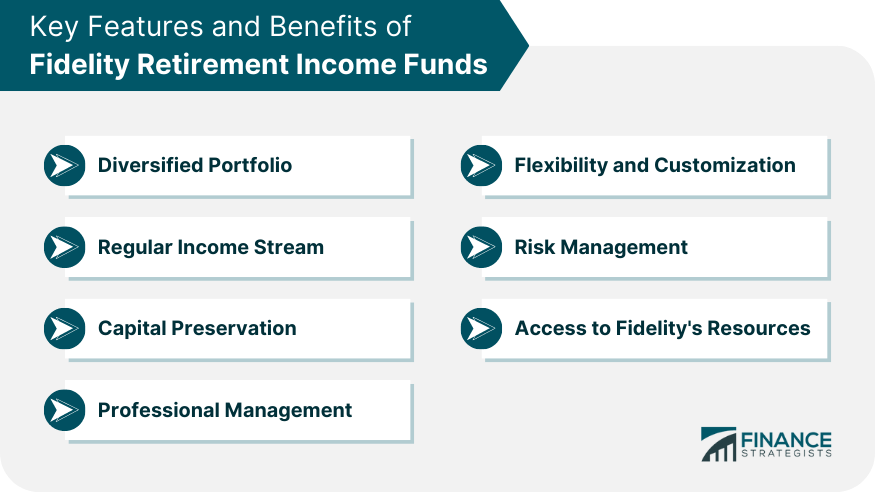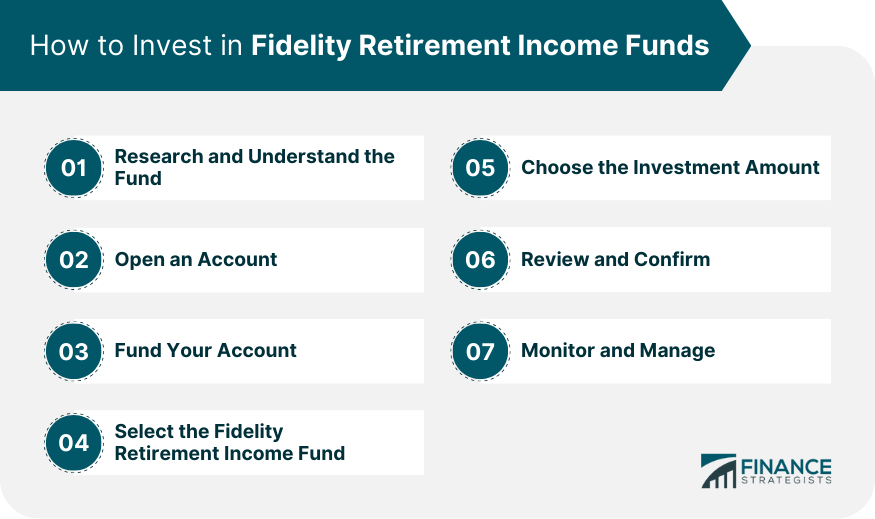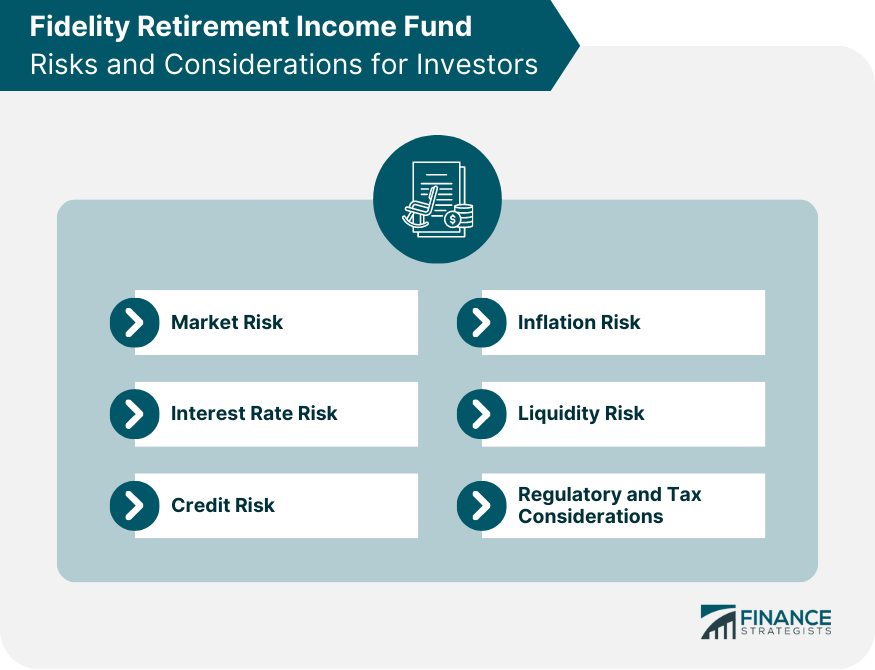Retirement income funds are investment vehicles specifically designed to provide a regular income stream to individuals during their retirement years. These funds typically consist of a diversified portfolio of income-generating assets, such as bonds, dividend-paying stocks, and other fixed-income securities. The primary goal of retirement income funds is to generate consistent and reliable income while preserving the principal investment. They aim to meet the financial needs of retirees by offering a balance between income generation and capital preservation, helping individuals sustain their desired lifestyle throughout retirement. Retirement income funds, including Fidelity Retirement Income Funds, are specialized investment vehicles tailored to provide individuals with a regular income stream during retirement. A Fidelity Retirement Income Fund is a specific type of retirement income fund offered by Fidelity Investments, a renowned financial services company. It is designed to provide retirees with a steady income stream during their retirement years. Fidelity Retirement Income Funds typically consist of a diversified portfolio of income-generating assets, such as bonds, dividend-paying stocks, and other fixed-income securities. The fund's objective is to generate consistent income while also considering capital preservation. Fidelity offers various Retirement Income Funds with different risk profiles and investment strategies to cater to the needs of different investors approaching or in retirement. These funds aim to help individuals meet their retirement income goals and manage their financial needs throughout their retirement journey. The Fidelity Retirement Income Fund offers several key features and benefits that make it an attractive option for retirees. These include: The fund maintains a well-diversified portfolio consisting of income-generating assets, such as bonds, dividend-paying stocks, and fixed-income securities. This diversification helps to spread risk across different asset classes and enhance the potential for returns. By investing in a mix of assets, the fund aims to provide retirees with a stable income stream while managing investment risk. One of the primary objectives of the Fidelity Retirement Income Fund is to generate a regular income stream for retirees. This income stream is designed to help meet retirees' financial needs and support a consistent lifestyle during retirement. By providing a reliable and predictable income source, the fund offers peace of mind and financial stability. While generating income is a crucial objective, the Fidelity Retirement Income Fund also focuses on preserving the principal investment. By employing a conservative investment approach, the fund aims to protect the value of the investment and provide retirees with a sense of stability. Capital preservation is particularly important for retirees who rely on their investment portfolio to sustain their retirement lifestyle. The Fidelity Retirement Income Fund is managed by a team of experienced investment professionals. These experts utilize a disciplined investment approach, leveraging their knowledge and expertise to navigate changing market conditions. The fund managers conduct in-depth research and analysis, make informed investment decisions, and regularly monitor the portfolio to optimize performance and manage risk. Retirees have different income needs and preferences, and the Fidelity Retirement Income Fund offers flexibility in terms of withdrawal options. Retirees can tailor their income streams according to their individual financial goals and circumstances. Whether they prefer a steady income stream or periodic withdrawals, the fund provides options that align with retirees' specific needs. The Fidelity Retirement Income Fund employs a strategic asset allocation strategy to manage risk effectively. The fund managers regularly review and adjust the portfolio based on market conditions and the fund's investment objectives. This proactive approach helps to mitigate potential risks and enhance the overall performance of the fund. By managing risk effectively, the fund aims to provide retirees with a smoother investment experience and potentially higher long-term returns. As a product offered by Fidelity Investments, the Fidelity Retirement Income Fund provides access to a wide range of resources. Retirees can benefit from Fidelity's extensive research capabilities, educational materials, and retirement planning tools. These resources can assist retirees in making informed decisions about their retirement income strategies and help them stay updated on market trends and investment opportunities. Investing in the Fidelity Retirement Income Fund is a simple process that requires careful consideration and planning. Here's a more detailed explanation of the steps involved: Before investing, take the time to thoroughly research and understand the Fidelity Retirement Income Fund. Review the fund's prospectus, which provides valuable information about its investment objectives, strategies, historical performance, fees, and risk factors. Pay attention to the fund's asset allocation, investment holdings, and any specific investment guidelines. This research will help you determine if the fund aligns with your investment goals and risk tolerance. To invest in the Fidelity Retirement Income Fund, you need to have an account with Fidelity Investments. Visit the Fidelity Investments website and follow the instructions to open an individual or retirement account. Provide the required personal and financial information, such as your name, address, Social Security number, employment details, and investment preferences. Fidelity Investments offers various types of accounts, including individual brokerage accounts, IRAs, and employer-sponsored retirement accounts like 401(k)s. Choose the account type that suits your needs. After opening an account, you need to fund it to have the capital necessary to invest in the Fidelity Retirement Income Fund. There are several options for funding your account. You can transfer funds from an existing Fidelity account, initiate a bank transfer from your linked bank account, or deposit a check. Follow the instructions provided by Fidelity Investments to fund your account securely. Once your account is funded, it's time to choose the Fidelity Retirement Income Fund as your investment option. Log in to your Fidelity account and navigate to the investment section. Search for the Fidelity Retirement Income Fund using its ticker symbol (if known) or name. Review the fund's details, including its investment strategy, historical performance, and expenses. Ensure that the fund aligns with your investment objectives and risk tolerance. Determine the amount of money you want to invest in the Fidelity Retirement Income Fund. This can be a lump sum investment or regular contributions, depending on your financial situation and preferences. Consider your investment goals, time horizon, and risk tolerance when deciding on the investment amount. Fidelity's online platform allows you to enter the desired investment amount easily. Before finalizing the investment, carefully review all the details of your transaction. Verify that the investment amount, account information, and fund selection are accurate. Pay attention to any fees or transaction costs associated with the investment. Take the time to read and understand any terms and conditions related to the investment. If everything is correct, proceed to confirm the investment. Once you have invested in the Fidelity Retirement Income Fund, it's crucial to monitor and manage your investment. Keep track of the fund's performance, review any communications or updates from Fidelity Investments, and stay informed about changes in the fund's management or strategy. Regularly assess whether the fund continues to align with your investment objectives and risk tolerance. Consider rebalancing your portfolio if necessary and make adjustments based on changes in your financial situation or goals. The Fidelity Retirement Income Fund is exposed to market risk, which refers to the potential volatility and fluctuations in the overall financial markets. Changes in market conditions can impact the value of the fund's investments, including stocks, bonds, and other securities. Market risk can result from economic factors, geopolitical events, or changes in investor sentiment. Investors should understand that the value of their investment can go up or down based on market conditions. The fund holds fixed-income investments such as bonds, which are sensitive to changes in interest rates. When interest rates rise, bond prices generally fall, which can negatively impact the performance of the fund. Conversely, when interest rates decline, bond prices tend to rise. Investors should be aware that changes in interest rates can affect the fund's returns and should consider the potential impact of interest rate movements on their investment. Credit risk is the risk associated with the potential default by issuers of fixed-income securities held within the fund's portfolio. This risk arises from the possibility that the issuer may be unable to meet its financial obligations, leading to a loss of principal or interest payments. The Fidelity Retirement Income Fund seeks to manage credit risk by investing in high-quality fixed-income securities. However, investors should be aware that there is still a level of credit risk involved and that defaults can occur, especially in lower-rated or non-investment-grade securities. Inflation risk refers to the potential loss of purchasing power over time due to the erosion of the real value of money. Inflation can erode the purchasing power of the income generated by the fund's investments, potentially reducing the fund's ability to maintain its purchasing power over the long term. Investors should consider the potential impact of inflation on their investment returns and ensure that their investment strategy accounts for this risk. Liquidity risk pertains to the possibility of difficulty in buying or selling assets without causing significant price disruptions. The Fidelity Retirement Income Fund may invest in less liquid securities or securities with limited trading volumes, which could result in reduced liquidity. During periods of market stress or when there is a lack of buyers or sellers in the market, it may be challenging to buy or sell securities at desired prices. Investors should be aware that liquidity risk could affect the fund's ability to meet redemption requests in certain market conditions. Investors should also consider the regulatory and tax implications associated with investing in the Fidelity Retirement Income Fund. Regulatory considerations may include compliance with investment regulations, disclosure requirements, and any specific rules or restrictions governing the fund's investments. It is essential to understand the regulatory framework within which the fund operates. Retirement income funds are investment vehicles designed to provide a regular income stream during retirement. Fidelity Retirement Income Fund, offered by Fidelity Investments, is one such fund that aims to generate consistent income while preserving the principal investment. It achieves this through a diversified portfolio, regular income stream, capital preservation, professional management, flexibility, risk management, and access to Fidelity's resources. To invest in the fund, research and understand its details, open an account with Fidelity, fund the account, select the fund, choose the investment amount, review and confirm the transaction, and monitor and manage the investment. Investors should be aware of the risks associated with the fund, including market risk, interest rate risk, credit risk, inflation risk, and liquidity risk. They should also consider the regulatory and tax implications of investing in the fund. It is crucial to evaluate these risks and considerations based on individual investment goals and consult with a financial advisor for personalized advice.Overview of Retirement Income Funds
What Is a Fidelity Retirement Income Fund?
Key Features and Benefits of Fidelity Retirement Income Funds
Diversified Portfolio
Regular Income Stream
Capital Preservation
Professional Management
Flexibility and Customization
Risk Management
Access to Fidelity's Resources

How to Invest in Fidelity Retirement Income Funds
Research and Understand the Fund
Open an Account
Fund Your Account
Select the Fidelity Retirement Income Fund
Choose the Investment Amount
Review and Confirm
Monitor and Manage

Risks and Considerations for Investors
Market Risk
Interest Rate Risk
Credit Risk
Inflation Risk
Liquidity Risk
Regulatory and Tax Considerations

Conclusion
Fidelity Retirement Income Fund FAQs
The Fidelity Retirement Income Fund is a mutual fund offered by Fidelity Investments that aims to provide a steady stream of income for investors during their retirement years.
The Fidelity Retirement Income Fund invests in a diversified portfolio of stocks, bonds, and other income-generating assets. The fund's objective is to generate regular income for investors while preserving capital and managing risk.
Investing in the Fidelity Retirement Income Fund can provide retirees with a convenient way to access regular income, diversify their investment portfolio, and benefit from professional fund management.
The Fidelity Retirement Income Fund may be suitable for retirees seeking income generation and capital preservation. However, individual suitability depends on factors such as investment goals, risk tolerance, and time horizon. It's important to review the fund's prospectus and consult with a financial advisor to determine suitability.
Yes, investors in the Fidelity Retirement Income Fund can generally make withdrawals, either as periodic distributions or lump-sum withdrawals. However, it's important to understand any potential fees, taxes, or restrictions associated with withdrawals and consult with a financial advisor for personalized advice.
True Tamplin is a published author, public speaker, CEO of UpDigital, and founder of Finance Strategists.
True is a Certified Educator in Personal Finance (CEPF®), author of The Handy Financial Ratios Guide, a member of the Society for Advancing Business Editing and Writing, contributes to his financial education site, Finance Strategists, and has spoken to various financial communities such as the CFA Institute, as well as university students like his Alma mater, Biola University, where he received a bachelor of science in business and data analytics.
To learn more about True, visit his personal website or view his author profiles on Amazon, Nasdaq and Forbes.











